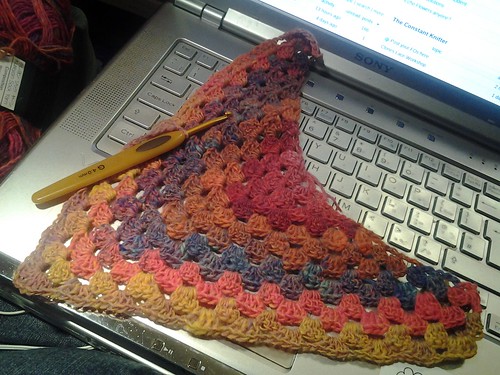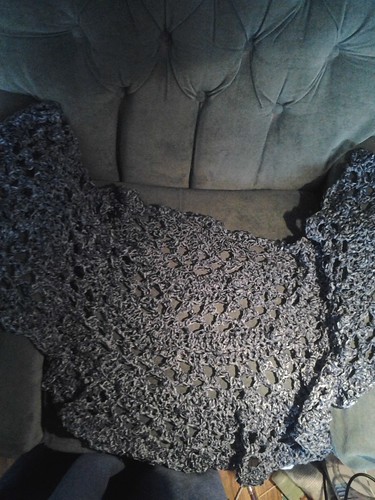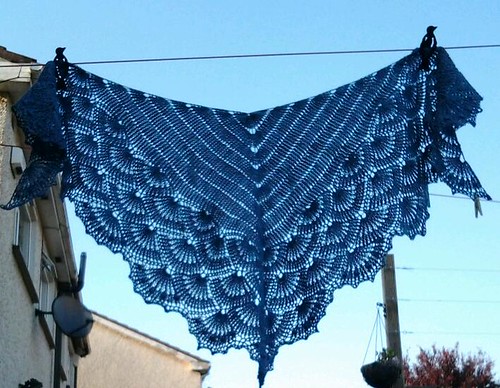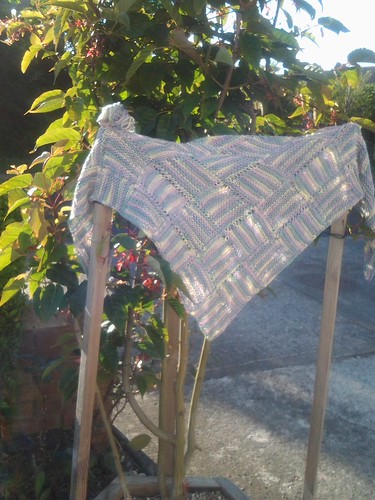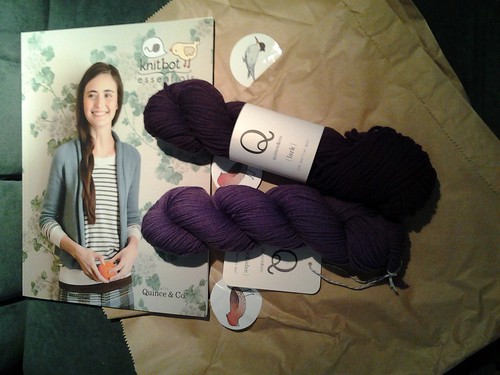From:
History of the Irish Vocational Education Association 1902-2002 - Jim Cooke
This is pretty much one of the most dry books I've read. There's a book underneath this text, a book about the development of education in Ireland and the changes in the emphases on what was taught, this is pretty much an account of the congresses and official moments of the Irish Vocational Education Association. It took me a while but these are the mentions of fibercraft in the book. This could be a good starting point for more research.
I will admit that a few other things that intrigued me crept in. Mostly for dating of when they occurred, yes, Aeronautical Engineering has really nothing to do with fibercraft, nor does Wind-generators for Electricity but it just made me stop and wonder at the time.
My mother was a domestic science teacher and my father was a Woodwork and Building Construction teacher, which did colour some of my choices. This is a launch-post for me for further research and I want to revisit some of the information at some later date. However there is a request in for this one and I have to hand it back.
p 13. The trade subjects [for the Dublin Schools] would be: Joinery, cabinet-making, coach-building, wood-carving and photography; to which list they hoped the next year [1888] to add weaving, mechanical engineering and book-making. In addition a wide range of science and art classes would be held.
p 35: Illustration of Glengarrif Technical School - lace making class
p 40 Domestic Economy c 1902 11 teachers
p 43 3 scholarships to residential schools of Domestic Economy
p 44 St Louis World Fair 1903-04. The technical education section included "a collection of samples of the work now being done by pupils in teh technical and art schools in Ireland, including specimens of enamelling, mosaic, tapestry, embroidery, stained-glass designs and specimens of lace and crochet and other of the art crafts as they are at present taught in Irish art schools"
p 46 Home industries were also being encouraged by the department by providing teachers in Crochet, sprigging, lace-making and machine knitting. [1906-07]
School for commerce and Domestic science at Rutland Square, later Parnell Square.
78. [in 1907-08] there was a system of itinerant instruction in Domestic Economy, manual instruction and building trade subjects, while crochet, sprigging and lace-making were taught and demonstrated in many areas also.
78 [1907-08] there were summer courses for teachers in 15 subjects and a special crochet course.
The industrial classes at Cahirciveen Presentation Convent were making good progress, as were the crochet classes which were related to the same cottage industry locally.
93. Notice to Co Galway Farmers [1908-09] "Do you want to make money/ Do you want your daughters to cook your dinner, nurse you when you are sick, earn money at crochet, and make their own dresses? ... If you do, write to the County Committee.
98. [1909-10] The World renowned Irish lace, crochet and Embroidery industry, as well as our other home industry, was being aided and developed by the Department.
115-6 In a paper on 'small industries' Mr George Fletcher emphasised that machine embroidery needed to be taken up, as the age of hand industries was largely gone [1914], it was a question of economics over aesthetic - Ireland was sending linen to Switzerland to be machine embroidered. The hand industries were not being completely ousted just as hand painting on cloth was not ousted completely by the three-colour machine process. Various speakers, however, argued for the superiority of the hand, artistically, over the machine process.
Cork's Woollen factories at Douglas, Blarney and Dripsey were referred to by Mr J F Crosley ARCScI in his paper on 'Woollen Industries'. The need for technical education at managerial level as well as at operative level were emphasized. There was a great demand for Irish tweeds and there was a secure future for the industry if it kept up with modern developments through technical education. Mr TP Gill said he had tried to get the woollen manufacturers to meet, but failed; but the Department did five scholarships to the sons of small woollen factory owners to study in England and bring back the best modern methods, and this scheme was successful in a number of cases.
119 It may be noted, that Bolton Street College of Technology had introduced classes in aeronautical engineering in 1911
121 in 1907-08 the 689 teacher students were distributed as follows:
Experimental Science (physics, chemistry, mechanical science, botany and physiology & Hygiene) 300
Laboratory Arts 33
Drawing and modelling 136
Domestic Economy 58
Manual Instructors (woodwork & Metalwork) 10
Building Construction 29
Woodcarving 5
Domestic Economy 20
Hygiene & Sick nursing 19
High-class cookery 20
Crochet etc 39
153 - [1914-1923 chapter] About 800 boys received instruction in English, Arithmetic, Drawing, Elementary Science and Manual work in Wood and Metal, while 1,000 girls were taught English, Arithmetic, Drawing, Cookery, Needlework, and Knitting.
155 There had been 373 teachers trained in a range of special subjects from wool dyes and dyeing to lithography. (between 1914-1923)
169: [Miss Elizabeth Bloxham, Co Wexford, representing the Domestic Economy Instructresses in the Free State, proposed that domestic economy should be taught to girls in primary school] She said that there was some sewing in the primary schools but no cooking.
188 [1924-29]
Number of students enrolled in classes in technical schools 1924-1927
Course
1924-25
1925-26
1926-27
Introductory
1757
1881
1738
Commerce
8811
9225
8390
Science (pure and applied)
3757
4009
4251
Handicraft
1009
1104
1434
Domestic Science
5354
5672
6521
Art
916
891
920
Miscellaneous
204
227
722
Total
21808
23009
23976
Number of Students enrolled in classes conducted under County Schemes of Technical Instruction other than established Technical Schools were
Course
1924-25
1925-26
1926-27
Manual Instruction
2460
3274
3942
Domestic Economy
4631
7138
6409
Home Spinning etc
605
687
673
Lace Sprigging and Knitting
363
678
550
Irish
23330
25137
20909
Commerce
884
2858
1626
Miscellaneous
1352
1645
1328
Totals
33625
41417
35437
212 [1933 congress] Mr J Earls, Principal, Municipal College of Technology, Belfast, delivered a paper on 'Technical Education in Belfast' and traced the history of the development from the textile school in 1884 to the present day College of 8,901 students and a staff of 351 persons. There was "a strong element of social activities with a modern languages society, an alembic (distilling) society, a textile society, a training college students union, and a dramatic society."
275. [1943] Subjects quite definitely of use to 'occupiers fo small farmsteads.'such as the preparation and cooking of meat and vegetable dishes, preserving fo fruit and making of jam, bread-making, laundry, needlework and home crafts, and elementary hygiene were included in all such courses.
285. [from the 1930 act] Students between 14 and 16 years, whether in employment or not, were required to attend school for 180 hours in the yar, in effect, a day each week for 36 weeks. The subjects for girls were Cookery, Dining and Cleaning, Needlework, Irish and English. For boys the subjects were English, Arithmetic, Irish and Woodwork.
291. Valuable courses in the construction of windchargers for rural lighting were given in 1942 in many centres whre the teachers of engineering had taken the summer course in that subject. There was generally a large enrolment in these classes in the smaller urban centres than in county schemes. In centres in County Wexford eight electrical sets were completed for use in rural areas. The best results were achieved in Mayo where over twenty sets were completed and installed. In Carlow Technical School a demonstration on Rural Electric Lighting was attended by over 200 adults from a radius of ten miles.
297 [1947] A paper by Mr L B Jones, Greenmount and Boyne Linen Co. Entitled 'Training for Textiles', referred to the co-operation between the textile industry and VECs. Mr Gerard L'Estrange referred to a 'wonderful co-operation' between a textile factory in Athlone and Co Westmeath VEC. Mrs Mary O'Rourke (Lenihan) a former Co Westmeath VEG member and minister for Education 1987-1999, whose father ran clothing factories in Athlone, recently recalled how "Mr Brendan O'Brien (the Vocational school Principal in Athlone) used to go to my father and they would place the boys and girls into General Textiles where there were a thousand in employment. Now I am talking about the '40s and the 50s, there was a direct placement agency between Brendan O'Brien and my father."
303 The Vocational school exhibition, at the RDS Spring Shows in 1947 and 1948, had shown articles in wood, metal, craftwork, needlework, embroidery, and films showing work typical of the urban and rural Vocational Schools and of apprenticeship courses.
335-6
RDS Spring Show, May 1947; Exhibition of Work of Schools
Through the courtesy of the Department of Agriculture the Department was able to organise an exhibition of the work of the Vocational schools in the Show at Ballsbridge in May, 1947. Specimen exercises in first and second year classes in Woodwork and Metalwork were on display, as well as finished articles such as inlaid desks, su/ga/n chairs, beehives, turf barrows, fire-irons, a set of iron gates, a brass gong and a concrete mixer. Great interest was aroused by the working of a water ram from Naas Vocational School. A working model, showed how running water could be provided in rural dwellings by a self-acting water pump called a hydraulic ram. Eight hundred leaflets explaining the operation of this pump were distributed to interested visitors. Another exhibit which attracted much attention was a small hand-loom for making scarves, sent in by the City of Waterford Vocational School.
355 Congress [1956] concluded with a paper by Mr Sea/n Bohan, County Librarian, Co Galway. He said school libraries were not mentioned in Departmental school reports and were neglected in Vocational schools. "A liberal education without books is unthinkable," he said.
361 [Congress 1957] Mr Michael Flannery, Wicklow County Manager, gave a paper on 'Utility with Beauty' and referred to the Town Planning Act and the need to create applied art in public buildings which would permeate into the houses of the countryside and the crafts of the people.
Ver Rev Fr T Mulvihill (Co Tipperary NR) said "The less of the glamour girl in the (Domestic Science) teacher the better... The rural Vocational schools should have girls ready to deal with poultry, pigs, cows and calves, rather than fancy stitches and queen cakes." Very Rev Canon Vaughan PP (Co Clare) said "Domestic Economy teachers were not glamour girls, they were very practical and close to the people and did everything from making calf baskets to cutting down cloth to make clothes fit children."
366 [congress 1959] Very Rev Canon Molloy, in his Presidential address,... welcomed the school organised activities of Macra na Tuaithe through it's rural science programmes e.g. the rearing of a calf of piglet, decorating a room, or knitting a two-piece suit. Macra na Tuaithe catered for 12-18 year olds...
367 To a resolution from Co Galway that a sufficient supply of teachers of art and arts and crafts, should be trained, Rev Bro Austin of Bray said that in the first Da/il, the Minister for Arts, Count Plunkett, had been an industrial artist and industrial design was greatly needed to be fostered in the present time.
372 "Like all other teachers, the Vocational teacher is primarily engaged not in filling pails with water, but in lighting fires, in starting chain reactions"
707-8 Industrial Training by VECs, report at the 1944 congress
7. There had also been many local VEC training schemes for Operatives in many of the new industries which had commenced since 1930, namely
2. The hosiery factories at Blackrock, Co Dublin
4. The Woolen Mills at Portlaoise and Kilkenny
6 The ready-made clothing factories at Cork, Drogheda, Dublin, limerick and Navan
11 Artificial Silk at Crolly, Co Donegal
14 the button factory at Manorhamilton, Co Leitrim
15 The Cotton Factory, Athlone
[the other mentioned are various other industries, non thread]

